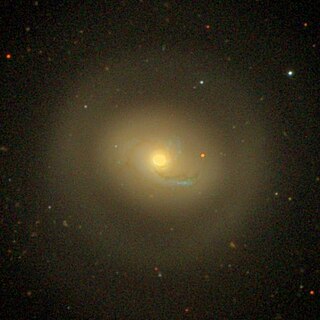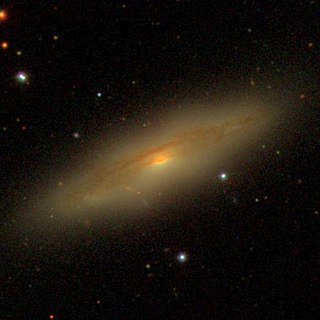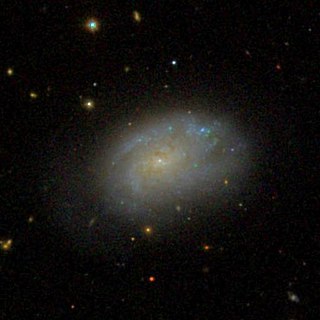
NGC 4309 is a lenticular galaxy located about 55 million light-years away in the constellation Virgo. The galaxy was discovered by astronomer Christian Peters in 1881 and is a member of the Virgo Cluster.

NGC 4457 is an intermediate spiral galaxy located about 55 million light-years away in the constellation of Virgo. It is also classified as a LINER galaxy, a class of active galaxy defined by their spectral line emissions. NGC 4457 Is inclined by about 33°. It was discovered by astronomer William Herschel on February 23, 1784. Despite being listed in the Virgo Cluster Catalog as VCC 1145, NGC 4457 is a member of the Virgo II Groups which form an extension of the Virgo cluster.

NGC 4606 is a spiral galaxy located about 55 million light-years away in the constellation of Virgo. NGC 4606 was discovered by astronomer William Herschel on March 15, 1784. It has a disturbed stellar disk suggesting the actions of gravitational interactions. NGC 4607 may be a possible companion of NGC 4606. However, their redshifts differ by about 600 km/s, making it unlikely that they are a gravitationally bound pair. NGC 4606 is a member of the Virgo Cluster.

NGC 4492 is a spiral galaxy located about 90 million light-years away in the constellation Virgo. NGC 4492 was discovered by astronomer William Herschel on December 28, 1785. It was rediscovered by astronomer Arnold Schwassmann on January 23, 1900, and was listed as IC 3438. NGC 4492 lies in the direction of the Virgo Cluster. However, it is not considered to be a member of that cluster.

NGC 4522 is an edge-on spiral galaxy located about 60 million light-years away within the Virgo Cluster in the constellation Virgo. NGC 4522 is losing its molecular gas though ram-pressure stripping as it plows though the cluster at a speed of more than 10 million kilometres per hour. The galaxy was discovered by astronomer John Herschel on January 18, 1828.

NGC 4586 is a spiral galaxy located about 50 million light-years away in the constellation Virgo. The galaxy was discovered by astronomer William Herschel on February 2, 1786. Although listed in the Virgo Cluster Catalog, NGC 4586 is considered to be a member of the Virgo II Groups which form a southern extension of the Virgo cluster. NGC 4586 is currently in the process of infalling into the Virgo Cluster and is predicted to enter the cluster in about 500 million years.

NGC 4595 is a spiral galaxy located about 42 million light-years away in the constellation Coma Berenices. NGC 4595 was discovered by astronomer William Herschel on January 14, 1787. NGC 4595 is a member of the Virgo Cluster.

NGC 4596 is a barred lenticular galaxy located about 55 million light-years away in the constellation Virgo. NGC 4596 was discovered by astronomer William Herschel on March 15, 1784. NGC 4596 is a member of the Virgo Cluster and has an inclination of about 38°.

NGC 4660 is an elliptical galaxy located about 63 million light-years away in the constellation Virgo. The galaxy was discovered by astronomer William Herschel on March 15, 1784 and is a member of the Virgo Cluster.

NGC 4222 is an edge-on spiral galaxy located about 60 million light-years away in the constellation Coma Berenices. It was discovered by astronomer William Herschel on April 8, 1784 and is often misidentified as IC 3087. NGC 4222 is a member of the Virgo Cluster and is a companion of NGC 4216 which lies about 180,000 ly (56 kpc) away. Despite this, the two galaxies are not interacting.

NGC 4237 is a flocculent spiral galaxy located about 60 million light-years away in the constellation Coma Berenices. The galaxy was discovered by astronomer William Herschel on December 30, 1783 and is a member of the Virgo Cluster. It is also classified as a LINER galaxy and as a Seyfert galaxy.

NGC 4294 is a barred spiral galaxy with flocculent spiral arms located about 55 million light-years away in the constellation Virgo. The galaxy was discovered by astronomer William Herschel on March 15, 1784 and is a member of the Virgo Cluster.

NGC 4298 is a flocculent spiral galaxy located about 53 million light-years away in the constellation Coma Berenices. The galaxy was discovered by astronomer William Herschel on April 8, 1784 and is a member of the Virgo Cluster.

NGC 4299 is a featureless spiral galaxy located about 55 million light-years away in the constellation Virgo. It was discovered by astronomer William Herschel on March 15, 1784 and is a member of the Virgo Cluster.

NGC 4302 is an edge-on spiral galaxy located about 55 million light-years away in the constellation Coma Berenices. It was discovered by astronomer William Herschel on April 8, 1784 and is a member of the Virgo Cluster.

NGC 4305 is a dwarf spiral galaxy located about 100 million light-years away in the constellation Virgo. The galaxy was discovered by astronomer John Herschel on May 2, 1829. Although considered to be a member of the Virgo Cluster, its high radial velocity and blue luminosity suggest it is in fact a background galaxy. The galaxy has a nearby major companion; NGC 4306.

NGC 4307 is an edge-on spiral galaxy located about 65 million light-years away in the constellation Virgo. It was discovered by astronomer Christian Peters in 1881 and is a member of the Virgo Cluster. It is also a LINER galaxy.

NGC 4312 is an edge-on unbarred spiral galaxy located about 55 million light-years away in the constellation Coma Berenices. It was discovered by astronomer William Herschel on January 14, 1787. NGC 4312 is a member of the Virgo Cluster and is a LINER galaxy.

NGC 4313 is an edge-on spiral galaxy located about 50 million light-years away in the constellation Virgo. It was discovered by astronomer William Herschel on March 15, 1784. NGC 4313 is a member of the Virgo Cluster and is classified as LINER and as a Seyfert galaxy.

NGC 4316 is an edge-on spiral galaxy located about 70 million light-years away in the constellation Virgo. It was discovered by astronomer Wilhelm Tempel on March 17, 1882. NGC 4316 is a member of the Virgo Cluster and is classified as LINER and as a Seyfert galaxy.




















